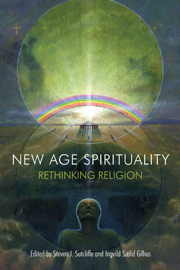Book contents
- Frontmatter
- Contents
- Introduction: “All mixed up” – thinking about religion in relation to New Age spiritualities
- Part I Rethinking New Age spiritualities
- 1 New Age, world religions and elementary forms
- 2 “All over the place”: the contribution of New Age to a spatial model of religion
- 3 Towards a new paradigm of constructing “religion”: New Age data and unbounded categories
- 4 On transgressing the secular: spiritualities of life, idealism, vitalism
- 5 Hiding in plain sight: the organizational forms of “unorganized religion”
- Part II Comparing New Age beliefs and practices
- Part III Putting new spiritual practices to work
- Conclusion: New Age spiritualities – “good to think” in the study of religion
- Contributors
- Further reading
- Bibliography
- Index
2 - “All over the place”: the contribution of New Age to a spatial model of religion
from Part I - Rethinking New Age spiritualities
- Frontmatter
- Contents
- Introduction: “All mixed up” – thinking about religion in relation to New Age spiritualities
- Part I Rethinking New Age spiritualities
- 1 New Age, world religions and elementary forms
- 2 “All over the place”: the contribution of New Age to a spatial model of religion
- 3 Towards a new paradigm of constructing “religion”: New Age data and unbounded categories
- 4 On transgressing the secular: spiritualities of life, idealism, vitalism
- 5 Hiding in plain sight: the organizational forms of “unorganized religion”
- Part II Comparing New Age beliefs and practices
- Part III Putting new spiritual practices to work
- Conclusion: New Age spiritualities – “good to think” in the study of religion
- Contributors
- Further reading
- Bibliography
- Index
Summary
“New Age” phenomena are frequently seen as atypical forms of religion, and a specific terminology is created to describe them. This terminology includes, for instance, terms like “New Age” itself, “New Religious Movements”, “new religiosity”, “neo-spirituality”, “spirituality”, “alternative religiosity”, “alternative spirituality”, and “holistic” Terms and theories establish the research object, which also means that terms highlight some aspects of a phenomenon and leave other aspects in twilight or darkness. Do the terms mentioned above point at the most characteristic aspects of the phenomena they describe – and if not, what terms could be used instead? In this chapter I will discuss the terminology of New Age phenomena in relation to a specific model for the study of religion and argue that to develop a fruitful terminology, it is necessary to develop a more complete and dynamic picture of contemporary religion. Religion in both the historical Roman Empire and in contemporary Norway is used as an example, and my broader argument is that a historical approach can provide important comparative insight into a phenomenon usually considered ur-contemporary.
TERMINOLOGICAL PROBLEMS
The terms mentioned above are problematic for several reasons. One problem is that they imply a polarized approach. Most of the terms situate their objects as secondary in relation to established religious institutions and religious power, for instance by using the prefix “new/neo” or the term “alternative” The dominance of the “world religion” category implies that “New Age” phenomena in the Western world are seen in relation to Christianity and to established churches.
- Type
- Chapter
- Information
- New Age SpiritualityRethinking Religion, pp. 35 - 49Publisher: Acumen PublishingPrint publication year: 2013



